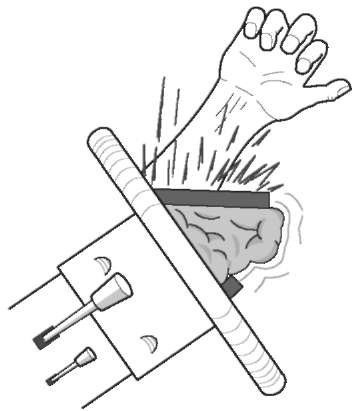Introduction
During the past decade the motoring public has been shocked to learn that air bags, a life-saving device promoted by the automotive industry, can also induce severe and fatal injuries. Over the last 10 years in the United States, nearly 200 men, women and children have been fatally injured by deploying air bags. Thousands more have sustained serious nonfatal injuries, including cervical spine fractures, closed head injuries, and multiple fractures and amputations of digits and hands. Ironically, the vast majority of these serious and fatal injuries were incurred in low and moderate speed collisions in which little or no injury would have been otherwise expected.
Historical Context
The first air bag patents were filed in 1952. Ford and General Motors began experimenting with these early prototypes in the late 1950s. Based on documents from the automotive industry, it was apparent, even as early as 1962, that deploying air bags had the potential to induce serious and fatal injuries, particularly to children. These early documents include analyses of tests conducted by Ford at their automotive safety research office in the late 1960s. The tests demonstrated that there was sufficient force associated with air bag deployment to traumatically eject a child from a vehicle. Ford also noted the amputation of a steel-hinged arm from a dummy secondary to the explosive force of deployment. When testing involved the use of animal models, the list of severe and fatal injuries grew. Cardiac rupture, hepatic rupture, splenic rupture, aortic and vena cava trans-ection, atlanto-occipital dislocation, cervical spine fractures, severe closed head injury and decapitation were observed.
Testing in the 1980s by the automotive manufacturers continued to demonstrate the risk of injury induction. One study conducted and reported by General Motors indicated ‘many of the exposures were at loading severities beyond the level representing an estimate of nearly 100% risk of severe injury’. These laboratory tests were completed and the knowledge available to the entire automotive industry well before air bags were placed in American-made vehicles.
With 40 years of research behind us and all of the resultant data before us, it is apparent that steering wheel and dash-mounted air bags, devices designed to protect occupants in high-speed frontal collisions, can also maim and kill.
Automotive Industry
During the period of 1960 to 1990, the automobile industry embraced an extensive research and development program regarding air bags. This testing involved anthropomorphic , anesthetized swine and baboons, and even human volunteers. It was recognized early on that occupants in the path of the deploying air bag, or who were positioned close to the air bag at the moment of deployment, were at a very significant risk of receiving a severe or fatal injury. In January 1970, at a meeting of engineers from General Motors, Ford and Chrysler, this information was discussed. As a result, a Chrysler engineer wrote: ‘This is a very serious problem that must be resolved for the inflatable restraint. Having a child directly in front of the bag when it inflates could prove fatal.’
General Motors tested air bags on baboons at Wayne State University during the early 1970s. The research indicated that ‘if the head is in the path of the deploying air bag, it is concluded that injury is likely to occur in the form of brain or neck injury to a child’.
Testing by Ford in the 1970s revealed that individuals involved in collisions at less than 32k.p.h. (20m.p.h.) experienced more severe injuries and loading forces in vehicles equipped with an air bag than those without one. Ford also noted that there was ‘overwhelming evidence that air bags may be dangerous for small children’. In 1972, a Ford engineer wrote the following warning, which was never placed in a vehicle: ‘The right front seat should be used only by persons who are more than five feet [1.52 m] tall and are in sound health. Smaller persons and those who are aged or infirm, should be seated and belted in the rear seat.’
In a series of tests conducted by General Motors in the 1980s, anesthetized swine were placed with their chests in close proximity to the air bag module. The tests revealed that when the swine’s thorax was impacted by the force of the deploying air bag and the air bag module, significant thoracic and abdominal injuries were sustained. These injuries in one case included: 17 rib fractures; two cardiac perforations; a splenic laceration; a liver hematoma and death within 30 min. The proximity of the occupant to the deploying bag and module cover were the pivotal contributory factors.
Human Injuries
The serious and life-threatening injuries that were originally observed in the industry’s laboratories using animal models began to be observed in humans on US roadways in the 1990s. The first six driver air bag-related deaths which were investigated by the government and the automotive industry revealed that the majority of these victims were women of short stature. It was also noted that the fatal injuries could be incurred even if the occupant was restrained by a lap and chest belt. The injuries initially seen included massive head injuries with diffuse axonal injury, subdural hematomas and skull fractures. Additional injuries evaluated included cervical spine fracture, cardiac perforation, pulmonary contusions and multiple rib fractures.
Sodium azide is the explosive propellant used to initiate the deployment cycle in most air bag designs in use today (Fig. 1). When sodium azide is ignited, the deploying air bag explodes toward the occupant at speeds of up to 336k.p.h. (210m.p.h.). An air bag system has two components, either one of which may induce injuries: the canvas-covered air bag itself and the air bag module cover (Fig. 2). Injuries incurred during deployment are relevant to the component inflicting them.
Obviously, the types of injuries which result from impact with the canvas air bag are different from those which result from impact with its module cover. There are three phases to air bag deployment: ‘punch out’, ‘catapult’ and ‘bag slap’. Injuries can be inflicted at any point during the deployment process:
• Punch out This is the initial stage of deployment. If the bag makes contact at this stage, the following injuries can result: atlanto-occipital dislocation, cervical spine fracture with brainstem transection, cardiac, liver and splenic lacerations, diffuse axo-nal injuries, subdural and epidural hematomas, and decapitation.
• Catapult This is the midstage of deployment when rapidly inflating bag ‘catapults’ or drives the head and neck rearward. This occurs with sufficient energy to rupture blood vessels, ligaments and fracture cervical vertebrae. The neck injuries occur as the result of cervical spine hyperextension.
• Bag slap This is the final stage of deployment which occurs at the bag’s peak excursion. Appropriately named, this happens when the canvas bag’s fabric may ‘slap’ the occupant’s face, resulting in injuries to the eye and epithelium.

Figure 1 The air bag is transported as an explosive material. Sodium azide is the explosive propellant used in the majority of air bag modules.
Figure 2 The injury-producing components of the air bag system are the air bag and the module cover which overlies it.
The air bag module covers are located in the steering wheel on the driver’s side and in the dashboard panel on the passenger side. As the bag deploys, the module cover is also propelled outward at speeds of up to 336k.p.h. (210m.p.h.). Most steering wheel designs house the horn within the air bag module compartment. Hand and arm injuries observed in individuals whose extremities were in contact with the module at the moment of its rupture include: degloving, fracture dislocation, fracture dislocation and amputations (partial and complete of digits and forearms). If the module cover makes contact with an occupant’s face, head or neck, skull fractures and severe or fatal head injuries, and decapitations have also been observed. The driver’s side cover is generally made with a rubberized plastic type of material, while the passenger side may have a metal housing. Contact with either type can prove fatal.
Specific Injury Patterns Ocular
The eye is extremely vulnerable to air bag-induced injury. These injuries range from corneal abrasions from contact with the air bag, chemical burns from contact with unburned sodium azide, to retinal detachment and globe rupture from the blunt force trauma of the expanding bag (Fig. 3). The wearing of eyeglasses in some cases has proven to be of benefit, as it offers a degree of barrier protection between the eye and the deploying bag.
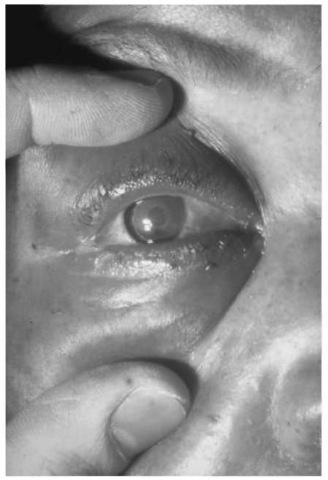
Figure 3 This patient sustained a severe corneal abrasion secondary to the membrane forces associated with air bag deployment.
Face and head
The most common injury associated with air bag deployment is that of facial abrasion. The abrasions result from a sliding contact between the bag and the face (Fig. 4). The injuries are not chemical ‘burns’ but deep abrasions.
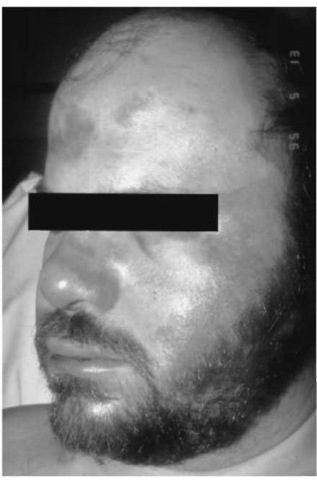
Figure 4 Abrasions to the cheeks, forehead and nose are the most common injury associated with air bag deployment.
Cranial and intracranial
When acceleration forces are applied to the cranial vault, a variety of traumatic injuries to the brain and surrounding structures will result. These include sub-dural hematomas, cortical contusions, atlanto-occi-pital dislocations, skull fractures and brainstem transections. Cranial injuries may result from contact with either the deploying of bag or module cover (Fig. 5).
Cervical spine
The blow from an air bag or module cover which produces a rapid and violent hyperextension of the cervical spine of the driver or passenger will have significant consequences for the cervical vertebrae. Injuries commonly seen as a result of hyperextension include atlanto-occipital dislocation, comminuted fractures of one or more upper cervical vertebrae, rupture of the anterior and posterior longitudinal spinal ligaments, and cervical spine disarticulation with transection of the cervical cord. The majority of these injuries are associated with the upper cervical vertebrae, although lower cervical vertebrae injuries have been observed.
Extremities
The upper extremities are very vulnerable to traumatic injury from the deploying bag and its module cover. When an individual’s hand or forearm is on or near the module cover at the moment of deployment, the occupant can expect to sustain multiple fractures, and/or tissue degloving or amputation of fingers, hand or forearm (Fig. 6). The horn-button-within-the-module cover design significantly increases the risk of injury to the occupant’s upper extremities at the moment of deployment. Many of these upper extremity injuries are associated with an occupant’s attempt to blow the horn, the button of which is located within the module cover. Forces from air bag deployment may be transmitted to the hand, wrist or forearm and may even involve the humerus. It is not unusual to see significantly comminuted fractures involving the wrist, forearm, elbow and distal humerus (Figs 7 and 8). The vehicles whose module covers are of a higher mass have the propensity to inflict more severe injuries. Some of the worst offenders are module covers located on the passenger side, which may have a soft coating of plastic on the exterior but have an underlying piece of rigid metal (Fig. 9B). The placement of hands on the passenger-side dashboard, in a bracing maneuver, has resulted in the traumatic amputation of hands and forearms (Fig. 9A).
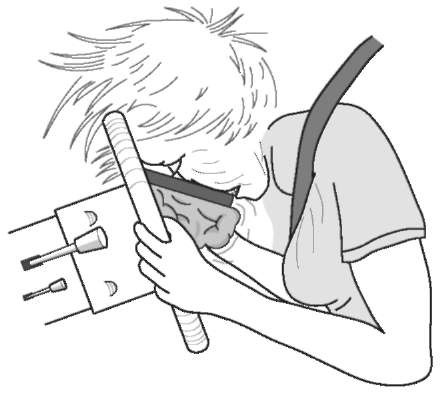
Figure 5 Cranial or facial contact with the deploying bag or
Figure 6 When the forearm is located in a horizontal fashion
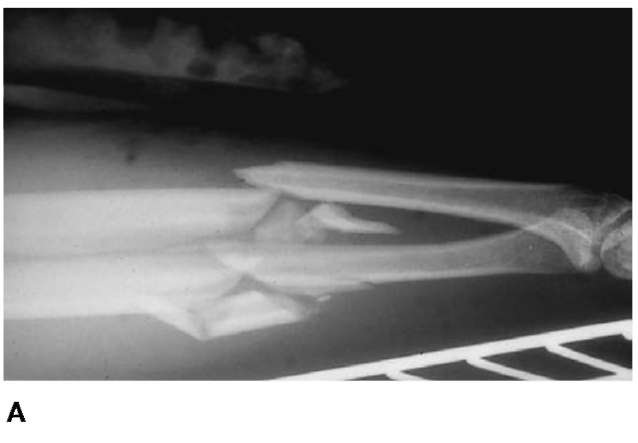
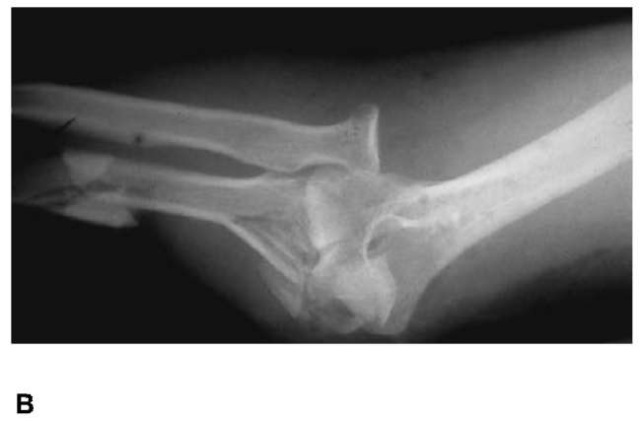
Figure 7 When the hand, wrist or forearm is on or near the module cover at the moment of deployment, for example when blowing the horn, significant fractures, degloving injuries and amputations will result. (A) This open-comminuted bending fracture of the radius and ulna was the result of contact with the module cover. (B) This patient sustained a comminuted fracture of the proximal and midshaft ulna as well as a radial head dislocation from impact with the module cover.
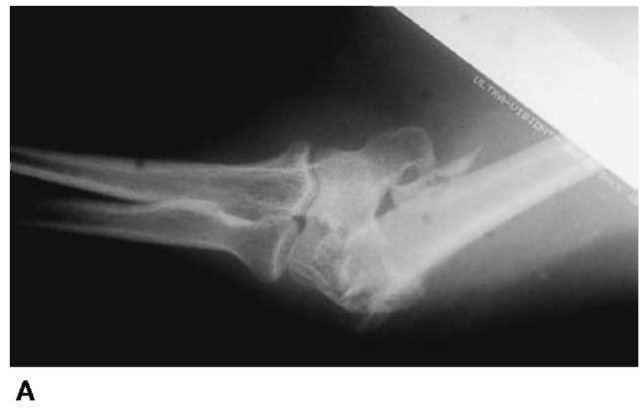
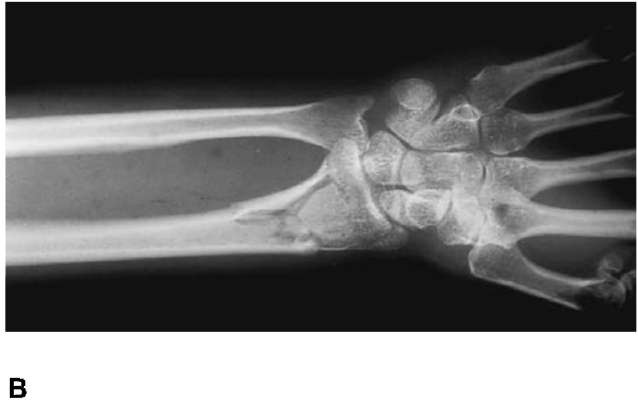
Figure 8(A) and (B) These severely comminuted fractures resulted when this individual was blowing her horn. She sustained a frontal impact of approximately 15k.p.h., which resulted in air bag activation. The horn activation button was located within the module cover, which explains why the patient had her forearms over the module cover at the moment of deployment.
Respiratory
The byproducts of combustion as well as other inert materials within the air bag may produce a white cloud within the vehicle. Many occupants have thought that this indicated a vehicle fire. This whitish material is principally cornstarch, talc and the byproducts of sodium azide combustion. There may be a small percentage of unburned sodium azide present within this powder as well. Inhalation of these materials can result in a chemical pneumonitis and the induction of asthma-type symptoms. These byproducts may also cause a chemical irritation of open wounds and a basic (high pH) burn to the eyes.
Sample Cases Case 1
A 35-year-old female, 1.57m (5′ 2″) and 50kg (110 lb.), was the restrained driver in a 1991 Ford Taurus (Fig. 10). The vehicle’s front bumper grazed a guard rail, which resulted in deployment of the driver’s air bag. The patient sustained an immediate respiratory arrest, with subsequent declaration of brain death 12h later.
A postmortem examination was conducted and revealed the following injuries: significant midface trauma with bilateral epistaxis; corneal abrasions; contusions of the chest; left subdural hematoma (overlying the frontal and parietal regions); subarachnoid hemorrhage and severe cerebral edema.
Examination of the exterior of the vehicle revealed very minor damage which was limited to the front bumper. The examination of the interior revealed a tear on the left lower portion of the module cover (Fig. 11). This tear was the result of contact between the left side of the victim’s face and the deploying module (Figs 5 and 11).
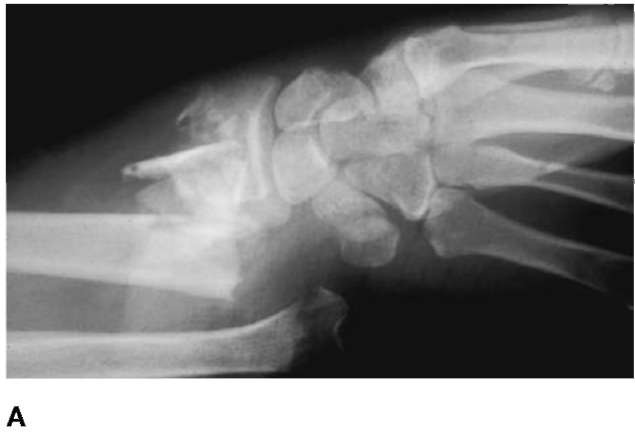
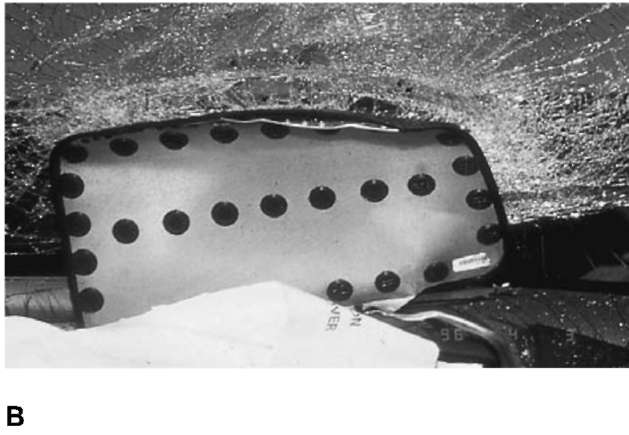
Figure 9 (A) This partially-amputated wrist was the result of placement of the front seat passenger’s hand on the dashboard at the moment of deployment. (B) The underlying structure of the module cover was metal.
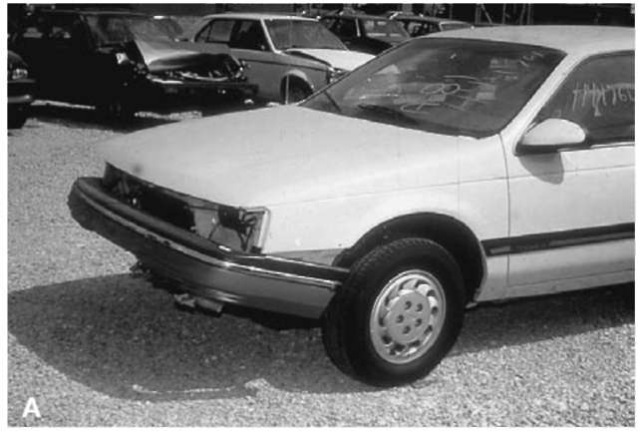
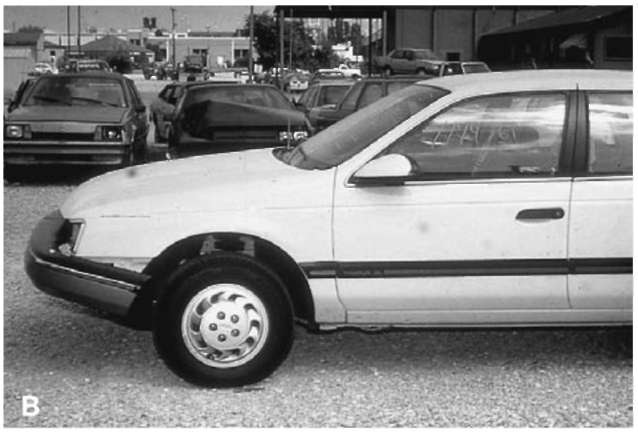
Figure 10(A) and (B) A 1991 Ford Taurus was involved in a very minor glancing collision between the front bumper and a guardrail. There was no underlying frame, fender or structural damage.
Case 2
A 4-year-old male was the lap belt-restrained occupant of the front right seat of a 1995 GEO Metro (Fig. 12). The shoulder portion of the harness was placed underneath the right arm. The patient was catapulted from the front passenger seat to the rear of the vehicle. The patient was found pulseless and apneic on arrival of emergency medical services.
A postmortem examination was conducted and revealed the following injuries: an atlanto-occipital dislocation with brainstem transection; large subdural hemorrhages; multiple rib fractures with underlying pulmonary contusions; liver and splenic lacerations; clavicular fracture and significant facial abrasions underlying the mandible bilaterally and on the right cheek (Fig. 13A). Examination of the abdomen also revealed a lap belt contusion below the umbilicus (Fig. 13B).
Examination of the vehicle revealed front end damage consistent with a change of velocity of less than 15 k.p.h. (9 m.p.h.). There was no damage to the driver or passenger compartments. Examination of the passenger bag revealed the presence of blood and tissue transfer. The patient’s injuries resulted from blunt force trauma to the chest and abdomen as well as a hyperextension injury of the neck with a rapid rearward acceleration.
Case 3
A 35-year-old female was the front seat passenger in a 1995 Nissan Altima. The patient was in a lap-shoulder belt, with the passenger seat in the most rearward position. The vehicle was stopped in a line of traffic, waiting for a traffic signal to turn, when it was hit from behind by a vehicle travelling at the speed of approximately 5 k.p.h. (3 m.p.h.). The rear impact pushed the Nissan forward into the trailer hitch of the truck in front. This resulted in air bag deployment. The air bag impacted the patient’s left eye. Examination of the face revealed significant periorbital trauma. There were abrasions on the forehead as well as on the cheek and chin. Examination of the eye revealed the presence of chemosis, a hyphema and a retinal detachment (Fig. 14).
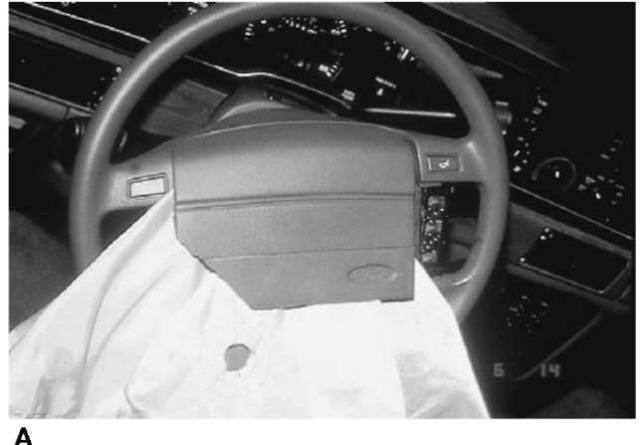
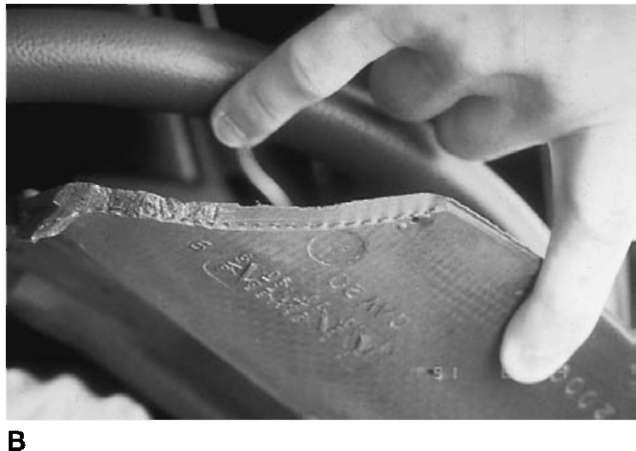
Figure 11 (A) The left lower corner of the module cover exhibited tearing from contact with the left side of the driver’s face. (B) Close-up of the module cover reveals the presence of a torn area. There is also an area which indicates this piece was removed by a sharp implement.
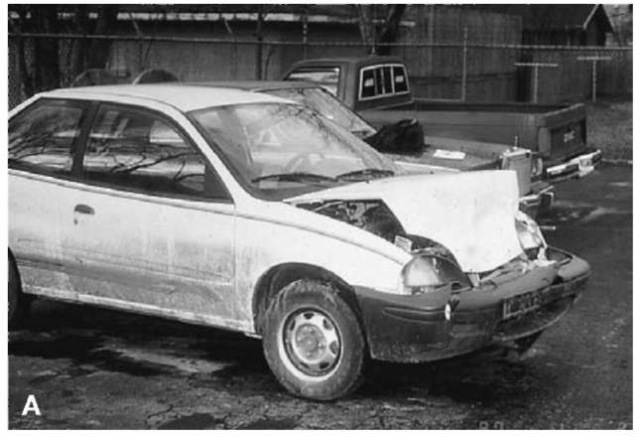

Figure 12 (A) and (B) A 1995 GEO Metro with minor front-end damage consistent with an impact speed of less than 15k.p.h. (9m.p.h.).
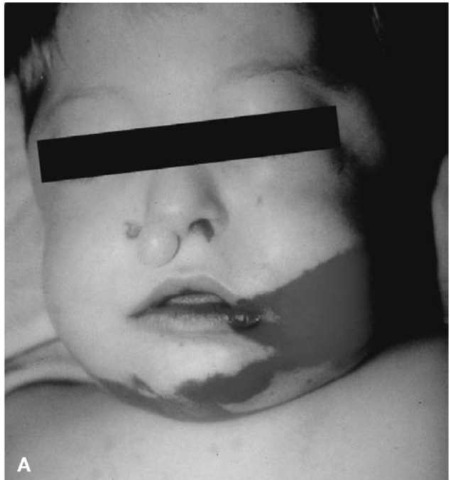
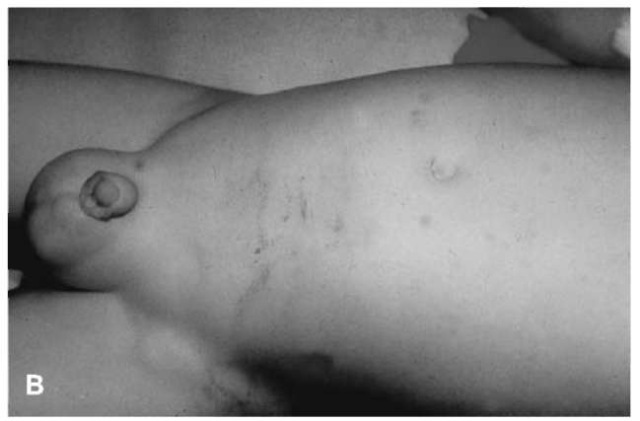
Figure 13 (A) This fatally injured 4-year-old male exhibits significant facial abrasion, overlying the mandible as well as abrasion on the left cheek. This was the result from contacts with the upwardly-deploying air bag. (B) Examination of the patient’s abdomen reveals a horizontally-oriented contusion consistent with a lap belt.
Examination of the vehicle revealed a 5 x 5 cm dent in the right front bumper (Fig. 15). There was no significant rear end damage. Examination of the bag revealed transfer of make-up and blood to the bag.

Figure 14 This 1.72 m (5′ 8″) restrained patient suffered permanent retinal detachment secondary to air bag contact.
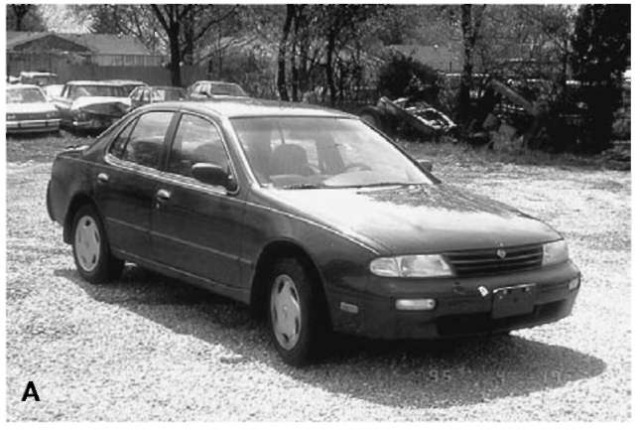

Figure 15(A) and (B) A 1995 Nissan Altima. The only damage to the vehicle is a 5 x 5 cm indentation in the front bumper from impact with the ball of a trailer hitch.
Forensics of Air Bag Injuries
Locard’s principle regarding the transfer of physical evidence between two impacting objects is dramatically evidenced in the case of air bags and air bag-induced injuries. The transfer of evidence to the air bag itself may take various forms. Blood and epithelial tissue transfer is, of course, common but transfer of make-up, including lipstick, rouge and mascara, to the air bag is also seen (Fig. 16). Analysis of the blood spatter pattern on the bag may assist the investigator in determining the position of the occupant and the configuration of the steering wheel at the moment of air bag deployment.
Examination of the air bag module cover may reveal the presence of trace evidence. Depending on the design of the module cover, there may actually be tearing or bending of the module cover, indicative of contact with an occupant’s more rigid (bony) surface: face or forearm. Scuff-type marks on the module cover indicate contact with an object, frequently the forearm (Fig. 17). Fabric imprints may also be seen on close inspection (Table 1).

Figure 16 Close examination of an air bag may reveal a multitude of transferred evidence. This evidence will include: hair, blood, epithelial tissue and facial makeup.
Summary
In the United States the deploying air bag has been responsible for nearly 200 deaths and thousands of severe injuries. It is clear that the forces of deployment are not insignificant and must be respected by the vehicle occupant. A review of the literature indicates that the serious and fatal injuries, which were once produced in the laboratory setting, are now being observed in ‘real-world’ collisions. Many clinicians may not be aware of the injury-producing power of the deploying air bag and must be informed of the patterns associated with air bag-induced injuries. The motoring public must also be informed and warned of the dangers of air bag deployment, just as the automotive industry was over 30 years ago.
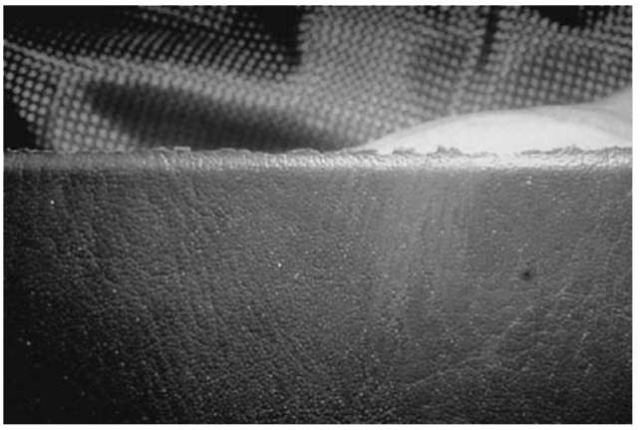
Figure 17 Close inspection of a module cover may reveal the presence of scuffing, and fabric imprints.
Table 1 Trace evidence.
| Air bag Blood Make-up Hair Tissue Module cover Tearing of cover material Scuff marking Fabric imprint Tissue Hair |

